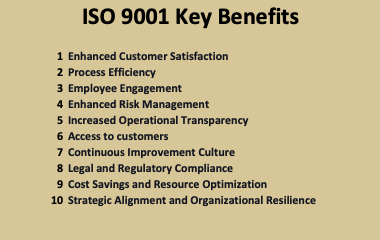In a recent article, we covered an introduction to ISO 9001; in today’s post, we thought we’d delve more into the benefits of implementing the quality management standard.
We’ll be covering:
- Why ISO 9001
- Benefits
- Enhanced Customer Satisfaction
- Process Efficiency
- Employee Engagement
- Enhanced Risk Management
- Increased Operational Transparency
- Access to customers
- Continuous Improvement Culture
- Legal and Regulatory Compliance
- Cost Savings and Resource Optimization
- Strategic Alignment and Organizational Resilience
Why ISO 9001
Organizations across various industries utilize ISO 9001 to help maintain consistent quality and efficiency, whether that’s to streamline operations, enhance customer satisfaction, or drive improvement.
Implementing ISO 9001 not only demonstrates a commitment to quality but also offers numerous tangible benefits which can positively impact both your bottom line and organizations reputation.
In this post, we’ll look at 10 key benefits associated with ISO 9001.

1. Enhanced Customer Satisfaction
So, let’s get this one straight: merely having an ISO certification does not drive customer satisfaction. It’s how you apply it and use your QMS to drive consistency that delights your customers.
Through its implementation, ISO 9001 encourages organizations to understand and meet customer requirements.
It helps to drive product and service quality and also has a systematic approach to customer feedback and complaint resolution, which all helps deliver high levels of service.
2 Process Efficiency
ISO 9001 relies on a process-oriented approach to quality management, emphasizing the identification, documentation, and optimization of key processes.
By analyzing and improving processes systematically, organizations can eliminate inefficiencies, reduce waste, and enhance productivity. This results in streamlined operations, shorter lead times, and cost savings, ultimately improving the organization’s competitiveness in the market.
3. Employee Engagement
ISO 9001 is the ideal vehicle if you’re looking to foster a culture of quality and continuous improvement.
Through training, clear communication of quality objectives, and involvement in decision-making processes, you can empower employees to actively participate in the organization’s success.
You can utilize ISO 9001 to help motivate employees to take ownership of their work and contribute to achieving organizational goals.
Of course, you’ll also need enablers like good communication, for example, but get it right, and your organization can capitalize on a number of benefits.
4. Enhanced Risk Management
Every business faces risks, ranging from supply chain disruptions to regulatory compliance issues. ISO 9001 encourages organizations to identify, assess, and mitigate risks systematically.
By implementing risk-based thinking, organizations can anticipate potential problems, implement preventive measures, and respond effectively to unforeseen events.
Having a proactive approach to risk management not only protects the organization from costly disruptions but also enhances resilience and adaptability.
5 Increased Operational Transparency
Transparency builds trust with stakeholders such as your customers, suppliers, and regulatory authorities.
ISO 9001 promotes transparency by establishing clear objectives, documenting processes and procedures, and ensuring compliance with relevant standards and regulations.
This transparency not only instils confidence in customers but also facilitates communication and collaboration across the organization and its supply chain partners.
6. Access to customers
ISO 9001 certification is internationally recognized and can serve as a passport to enter new markets or deal with a more divers customer base.
For example, some potential customers may mandate ISO as part of being allowed on their Approved Supplier Lists.
By implementing ISO 9001, organizations demonstrate their commitment to quality and compliance with standards, thereby gaining a competitive edge and enhancing their reputation on a global scale.
ISO 9001 certification can also opens doors to potential partnerships and collaborations.
7. Continuous Improvement Culture
Continuous improvement is a core aspect of ISO 9001. The Plan-Do-Check-Act (PDCA) cycle provides a systematic framework for driving continual improvement in processes, products, and services. By regularly monitoring performance, collecting data, and implementing corrective and preventive actions, organizations can iteratively enhance their operations and deliver greater value to customers. ISO 9001 cultivates a culture of innovation and learning, where employees are encouraged to challenge the status quo and strive for excellence.
8. Legal and Regulatory Compliance
Compliance with legal and regulatory requirements is fundamental for businesses operating in various industries.
ISO 9001 helps organizations stay ahead of the curve by ensuring compliance with relevant laws, regulations, and industry standards.
By establishing robust processes for document control, record keeping, and change management, ISO 9001 minimizes the risk of non-compliance and potential legal liabilities. This not only protects the organization’s reputation but also fosters trust among stakeholders and regulatory authorities.
9. Cost Savings and Resource Optimization
While implementing ISO 9001 requires initial investment in training, documentation, and certification, the long-term benefits far outweigh the costs. By improving process efficiency, reducing waste, and preventing errors and defects, ISO 9001 can lead to cost savings over time.
10. Strategic Alignment and Organizational Resilience
ISO 9001 aligns quality management practices with the organization’s strategic objectives, ensuring that quality is integrated into every aspect of the business. By fostering a holistic approach to quality, ISO 9001 enables organizations to adapt to changing market dynamics, customer needs, and technological advancements. This strategic alignment enhances organizational resilience, agility, and long-term viability in a rapidly evolving business environment.
Summary
As we can see by implementing ISO 9001 its possible to capitalize on a number of benefits that drive organizational excellence, customer satisfaction, and sustainable growth.
Having relevant goals in sight acts not only as a motivator but also provides direction despite the effort and hard work required across the organization.
From enhanced quality and efficiency to greater employee engagement and global market access, ISO 9001 provides a solid foundation for success in today’s challenging landscape.
